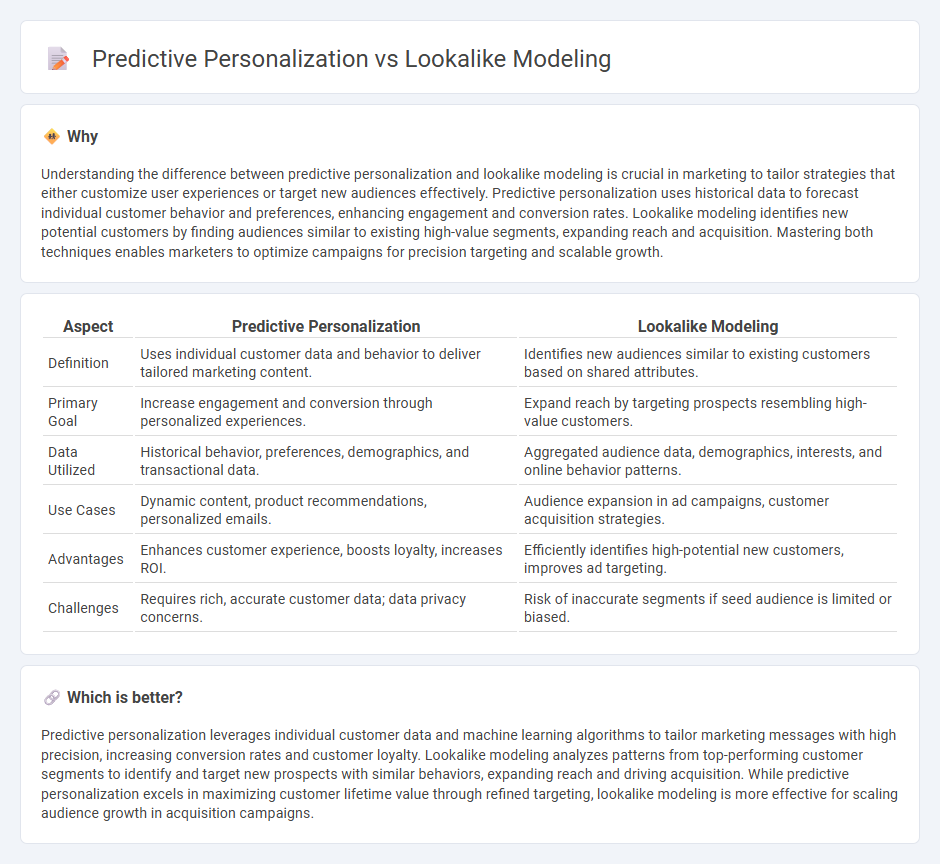
Predictive personalization leverages customer data and machine learning algorithms to tailor marketing efforts to individual preferences and behaviors, enhancing engagement and conversion rates. Lookalike modeling identifies new potential customers by analyzing similarities to existing high-value audiences, expanding reach effectively. Explore these approaches to optimize your marketing strategies and drive better ROI.
Why it is important
Understanding the difference between predictive personalization and lookalike modeling is crucial in marketing to tailor strategies that either customize user experiences or target new audiences effectively. Predictive personalization uses historical data to forecast individual customer behavior and preferences, enhancing engagement and conversion rates. Lookalike modeling identifies new potential customers by finding audiences similar to existing high-value segments, expanding reach and acquisition. Mastering both techniques enables marketers to optimize campaigns for precision targeting and scalable growth.
Comparison Table
| Aspect | Predictive Personalization | Lookalike Modeling |
|---|---|---|
| Definition | Uses individual customer data and behavior to deliver tailored marketing content. | Identifies new audiences similar to existing customers based on shared attributes. |
| Primary Goal | Increase engagement and conversion through personalized experiences. | Expand reach by targeting prospects resembling high-value customers. |
| Data Utilized | Historical behavior, preferences, demographics, and transactional data. | Aggregated audience data, demographics, interests, and online behavior patterns. |
| Use Cases | Dynamic content, product recommendations, personalized emails. | Audience expansion in ad campaigns, customer acquisition strategies. |
| Advantages | Enhances customer experience, boosts loyalty, increases ROI. | Efficiently identifies high-potential new customers, improves ad targeting. |
| Challenges | Requires rich, accurate customer data; data privacy concerns. | Risk of inaccurate segments if seed audience is limited or biased. |
Which is better?
Predictive personalization leverages individual customer data and machine learning algorithms to tailor marketing messages with high precision, increasing conversion rates and customer loyalty. Lookalike modeling analyzes patterns from top-performing customer segments to identify and target new prospects with similar behaviors, expanding reach and driving acquisition. While predictive personalization excels in maximizing customer lifetime value through refined targeting, lookalike modeling is more effective for scaling audience growth in acquisition campaigns.
Connection
Predictive personalization leverages data analytics and machine learning to forecast individual customer preferences, enabling tailored marketing strategies that enhance engagement and conversion rates. Lookalike modeling identifies new potential customers by analyzing shared characteristics of existing high-value customers, expanding the reach of personalized campaigns. Both techniques rely on advanced predictive algorithms to optimize targeting accuracy, driving more effective and efficient marketing outcomes.
Key Terms
Lookalike Modeling:
Lookalike modeling uses machine learning algorithms to identify new audiences with similar behaviors and characteristics to a brand's best customers, enhancing targeting efficiency in digital marketing campaigns. It leverages data points such as demographics, purchase history, and online behavior to pinpoint potential high-value users, driving improved conversion rates and ROI. Discover more about how lookalike modeling can transform your customer acquisition strategy.
Seed Audience
Lookalike modeling identifies new potential customers by analyzing the characteristics of a Seed Audience, expanding reach based on demographic, behavioral, and interest similarities. Predictive personalization uses data from the Seed Audience to create individualized experiences, optimizing content and offers to increase engagement and conversions. Explore how leveraging your Seed Audience can maximize marketing effectiveness through these advanced targeting strategies.
Similarity Algorithms
Lookalike modeling leverages similarity algorithms to identify new audiences that share characteristics with existing high-value customers, optimizing marketing reach and acquisition. Predictive personalization uses similarity measures to tailor individual experiences by predicting user preferences based on patterns in historical data. Explore deeper insights into similarity algorithms to enhance both lookalike modeling and predictive personalization strategies.
Source and External Links
Back to Basics: What is Lookalike Modeling? - Lookalike modeling is a data-driven process that uses machine learning to identify and target new audiences who share the demographic and behavioral characteristics of your best existing customers, helping brands expand their reach and improve campaign effectiveness.
Look-alike Modeling: What it is and How Does it Work? - Look-alike modeling finds groups of people who resemble your most profitable customers in terms of behavior and attributes, enabling marketers to prospect for new, high-potential customers beyond their current audience segments.
Lookalike Modeling: An Effective Way to Find High-Value ... - Lookalike modeling applies machine learning algorithms to score individuals based on their similarity to a seed audience, allowing brands to efficiently discover and engage high-value prospects that match their ideal customer profile.
 dowidth.com
dowidth.com